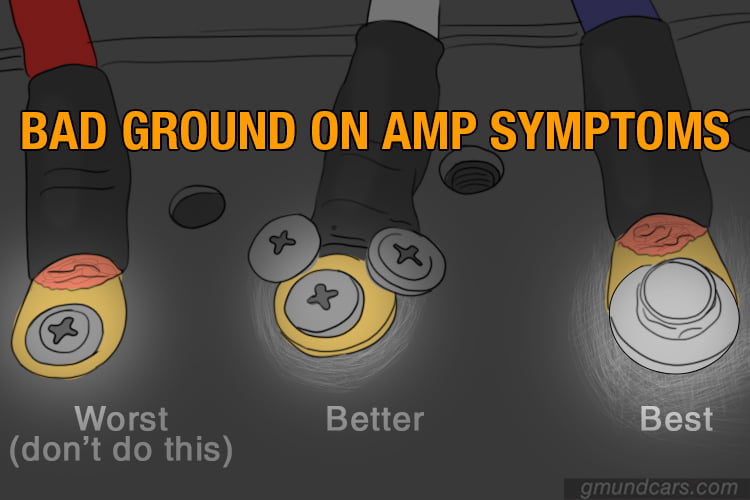A properly grounded system ensures stable voltage levels in your car’s stereo. Absence of suitable grounding can result in problems such as clipping, overheating, recurrent activation of protection mode, and uneven turning on/off, which are some of the adverse effects of poor amp grounding.
Let’s dig deeper into these problem indicators and see what you can do when you encounter any of them. I’ll also show you how to properly ground an amp and tips on the best places to ground an amp on your car or truck.

What Is Bad Ground On Amp?
Bad ground exposes the amplifier’s audio signal to electrical shock, making the current flow to undesired locations. Therefore, it indicates permanent damage to your vehicle’s speaker amplifier and any other connected audio devices.
Bad ground on the amp happens gradually. Usually, you will see a few warning signs before it happens. Once you start seeing indicators such as clipping or overheating, it’s best to tackle the issue immediately.
Bad Ground On Amplifier Symptoms

Symptom #1. Overheating

A bad ground connection prevents proper heat dissipation, which in turn causes the amplifier to overheat. While many things can cause an amp to overheat, bad ground is usually the culprit. In this case, a short or loose wire is misbalancing the power handling of the amp, resulting in a thermal breakdown.
To prevent this problem, you need to ensure that the ground wire is just about the same precise size as the power wire. You should also fasten the ground wire firmly to a portion of the car’s chassis that has been scrubbed down to bare metal and sanded down.
Some other causes of an overheating amp include:
- Blasting music for long hours in succession
- Poor ventilation
- Using a low-quality amp
- Improper installation
- Clipping
- Case with clogged amp
- Poor construction quality
Symptom #2. Clipped Sound Signal

Poor or improper grounding prevents the amp from sending the required voltage to the connected speakers and subs, resulting in clipping. This messes with the waveform of the transmitted signal and results in distorted sound.
Continuous distortion of the audio signal can leave the speakers vulnerable to damage. The main reason for amp clipping is poor or improper grounding. Still, other things can cause amp clipping.
These include:
- Wrong size of wire gauge
- Using the inadequate alternator
- High input gain
- Over-equalization of the input signal
- Overheating
Symptom #3. Going Into Protection Mode When Car Starts

Another symptom of bad ground on the amp is when the amp goes into protection mode and switches off due to failure in the circuitry or overheating. The protection mode is designed to prevent damage to the interior components of the amp.
It’s not easy to tell that your amp has gone into protection mode. Some amplifiers switch off, while others have a protection mode indicator. To this end, you’ll need to check what to look for in the owner’s manual to know when the amp enters the protection mode.
Nonetheless, suppose your amp is not overheating, and it’s switching off randomly and won’t turn back on immediately. In that case, the problem is most likely with your ground wiring or loose connections.
Symptom #4. Not Turning On

An amp that is not turning on is another good indicator of bad ground. Remember that grounding completes the electrical circuitry that’s powering your amplifier. When your amp has bad grounding, it will not turn on at all.
The ground and power wires must be thick enough to accommodate the power needs of your amps. Furthermore, you should ensure that the ground wire has a firm and secure connection and that it’s grounded to a frame that’s clean of any paint.
An amplifier that’s not turning on can also be a result of other things such as:
- Lack of voltage in the power cable
- Absence of remote
- Blown fuse
- Amp attached to a conduction material
- Improper grounding
Symptom #5. Restarting All The Time

When your amplifier cuts in and out randomly, there’s a strong chance of being poorly grounded. It’s one of the most common symptoms of bad ground on the amp. This is because of a broken or loose cable that occasionally connects, causing the amp to restart continuously.
Hence, you should ensure that you do not have any loose wires that could produce a circuit breaker, plus every connection must be tight. Then, go ahead and confirm that the ground wiring has the correct level of tension and security.
While poor grounding is often behind an amp cutting in and out, other factors can contribute to this scenario. These are:
- Clipping
- Overheating
- Impedance mismatch
- Speakers not connected properly
- Defective internal components
- Amp starvation
Symptom #6. Whining Noise

There are two leading causes of a whining noise in your amplifier. One is poor amp mounting, and the other is improper grounding. These two can cause a whining noise in your car’s stereo system, but they are pretty easy to fix.
First, ensure that you’ve grounded the amp properly. Second, make sure that the amp’s metal casing is away from the vehicle’s chassis. If the whining is too loud and does not stop entirely after these two fixes, it’s best to introduce a filter or noise suppressor.
Moreover, do not go beyond 18 inches long with your ground wire. When it’s too long, it will cause noise problems.
Other causes of a whining noise can be attributed to the antenna wire and patch wires. However, it’s not easy to pinpoint whether these wires are the source of the problem. That’s why a noise suppressor comes in handy.
Symptom #7. Burning Smell

Perhaps the most obvious and worse indicator of poor amp grounding is the smell of something burning. It can quickly become a dangerous fire hazard because it is caused by a loose ground that creates friction at the ground connection. In turn, the friction can melt the amp ground terminal, launch a spark, and eventually cause a fire.
As a result, it always helps to ensure that the ground wiring is fastened securely to prevent disaster.
Read more: How can I choose the best car amplifier? [top 5 products review]
How To Properly Ground An Amp
The ground wiring of your amp can save or destroy your car’s audio system. That is why it’s essential to do it right. Using this step-by-step guide, you can ensure that your amp is adequately grounded.

Step #1. Look For The Best Grounding Location
First, identify a suitable location for the proper grounding within 18 inches of the amplifier. It should be as close as your amp.
Ideally, it would help if you ground your amplifier to the factory grounding point, which is usually a stud secured to the car’s metal chassis. If not, you’ll have to drill a grounding point on a bare area on the vehicle’s chassis to secure a bolt or screw. It’s essential to look out for wires or a fuel tank in the drill path.
Step #2. Clean The Grounding Surface
Whether you’re grounding to the factory grounding point or a different location, you’ll need to clean that surface. The stud usually has lots of paint, so the first thing you’ll need to do is to scrape off the paint to expose the stud completely.
Step #3. Cut The Ground Wire
Cut the ground wire into the length you’ll use. Additionally, make sure that it has a thick gauge to accommodate the amplifier’s power needs. If you use a power wire that’s not thick enough, it may result in overheating or, in worst cases, burning of the amplifier.
Step #4. Attach The Wire
After you have the correct length of wire, strip it and attach the naked end to the receiver. Next, look for a grounder connector port behind the amplifier and connect the wire. Make sure it is firm and secure.
Step #5. Tighten The Grounded Port
After attaching all the wires, ensure that you tighten the remaining around the amplifier. I find that tape secures the wires firmly.
Step #6. Test The Amplifier
After successfully grounding your amp, please switch it on and test the receiver using suitable tools.
What Does Good Ground Look Like?

Read more: How to install a car amplifier [with infographics]
How To Test An Amp
Testing if a car amplifier is working is pretty straightforward. However, it would help to be mindful of a few things. First, ensure that the polarities are correct whenever you hook up any electrical unit to your vehicle. Second, it’s not advisable to test your amplifier on your car if it has any burn marks.
You will need:
- Car battery
- Working speaker
- Working stereo receiver with RCA outputs
- RCA cable
- Power wire (red), ground wire (black)
Here are the steps:
Step #1. Check amp’s circuit board
Hook the ground wire to the amp and connect it to the battery’s negative. Then, hook the power wire to the positive of the battery. The amp’s circuit board is good if the power light is on.
Step #2. Check the connection of stereo
Connect the RCA cables to the stereo and the amp. Then, connect the amp to the speakers. This step is to ensure that the amp is putting out sound.
The power and sound should come on. If there’s no sound, it’s likely that the amp previously suffered an overload and will not turn back on. If there’s clear sound coming from the speaker, the amplifier is in good condition.
Read more: How to Make Car Door Speakers Sound Better?
Step #3. Check fuses
In this step, check all the fuses for continuity. In some cases, a cracked or corroded fuse can prevent an amp from coming on, even if it’s properly grounded and connected correctly. The fuse connection on an amp is usually a color-coded two-pronged wire with a plastic body.
Look out for an inline fuse on the power wire. If the fuse is twisted or cracked, it will need to replace the amp to turn on.
Frequently Asked Questions (FAQs)
1. What are the signs of a bad car amplifier?
An amplifier can fail suddenly or with time. In some cases, it’s a problem you can fix, while in others, you will need to replace the amplifier completely.
Please look out for these symptoms to diagnose a faulty amp.
- Not turning on at all
- Excessive humming, whining, or buzzing sound
- Fast and excessive overheating
- Constant amp restarting or cutting out
- Blowing fuses for no apparent reasons
- Inconsistent or weak bass output and power loss
- Burning smell when playing at loud volume
- Protect light comes on
2. What are blown amp symptoms?
A blown amplifier will ruin your listening experience. These signs will tell you if your amp is blown.
- Noticeable sound distortion.
- The system starts producing peculiar sounds such as farting sounds.
- There’s no sound from the speakers, even if the audio system is on.
If you notice any of these signs, check out your amplifier for problems right away. Also, look for problems in other connected audio devices since they may also be causing the issues.
3. What happens if you don’t ground your car stereo?
The ground wire allows your car stereo to operate correctly. Hence, you cannot run a car stereo without proper grounding. Without grounding, your audio system will malfunction every time you turn it on.
4. What are the symptoms of bad RCA cable?
If your RCA cables are going bad, they will show you some signs to indicate it. Before their eventual breakdown, you will notice whining, buzzing, or humming when you’re driving. This is most likely due to a damaged pair of RCA cables shorting out. In this case, you will need to perform system checks using a multimeter.
Conclusion
There you go, guys. These are the most common bad ground on amp symptoms. I hope you can watch out for the signs I’ve discussed here so you can be in the know before it’s too late to save your amp. Remember to ensure that the amp is grounded correctly and that there are no loose wires before concluding that your amplifier has gone bad.
Good luck!
